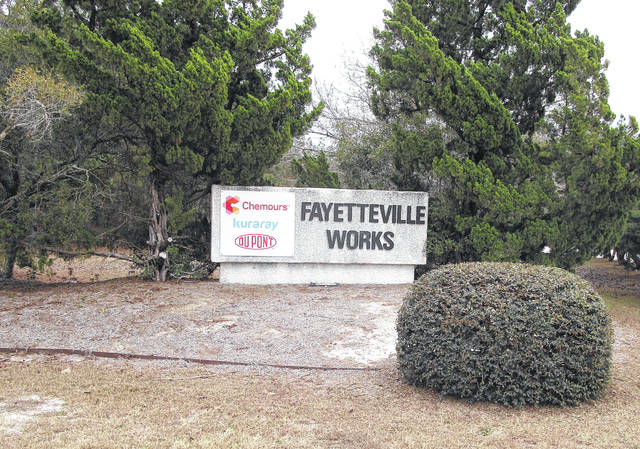ST. PAULS — Like the chemical itself, the controversy over GenX is spreading to legislators, regulatory agencies and the courts.
State and local testing of private wells has ended for now, but tests continue on the dispersal of GenX through the air, and into rain, surface water and wildlife.
State and federal lawsuits rising from up and down the Cape Fear River are poised to be filed against DuPont and its spinoff Chemours, the chemical company currently responsible for the manufacture, use and disposal of the chemical suspected of being a health hazard.
“We were asked to join a federal class action suit, but declined,” said Patsy Sheppard, whose farm and home in Bladen County adjoin Chemours property. “We’ve hired an attorney and plan a civil suit in state court.”
Lawyers, some who were involved in a $300 million settlement against DuPont in the Ohio River valley, are hovering around the former DuPont facility, now owned by Chemours. That suit involved a chemical known as C8, which DuPont replaced with GenX about 10 years ago.
Early this summer, Chemours launched a public relations campaign in which company leaders are telling the public that GenX is safe at far higher amounts than the levels set by the federal Environmental Protection Agency (70 parts per trillion) and the state Department of Environmental Quality (140 ppt).
At a recent public meeting, Chemours Plant Manager Brian Long said he would be comfortable letting his grandchildren drink water with higher levels of GenX in it.
“Actually, I would,” he said.
The company, leaders of which have said 700 jobs at stake, has hired its own scientist and is lobbying the North Carolina General Assembly for assistance.
According to news reports, the EPA has a blockbuster study of GenX and its family of related chemicals that has not been made public. One observer told the media it is a “public relations nightmare” for the chemical industry.
A local meeting with EPA representatives has been promised for some time in August.
Ongoing tests of six home water filtration systems have been successful, but the cost and maintenance of the system is expected to be high. The tests have led some to believe that public water systems could also filter out chemicals like GenX.
Chemours has footed the bill for tests, but with about 300 contaminated wells, filtration systems for all would be costly. State officials say connecting affected homes with public water systems is the long-term solution.
None of the filtration test sites are in Robeson County, said Bill Smith, director of the Robeson County Health Department, which has tested 100 Robeson wells close to the plant. Two Robeson County wells tested above 140 ppt, and one contained a significant amount of another related chemical, known as C8.
“The contaminated wells in Robeson County were switched to county water,” Smith said.
The wells were located about 3.5 miles from the Chemours facility.
Smith said Chemours has not answered questions about how much the granular carbon filtration systems cost or how much they cost to operate.
A study just released by the Agency for Toxic Substances and Disease Registry, a division of the federal Department of Health and Human Services, gives no clear answers about human health effects of GenX and 14 other perfluoroalkyl compounds used in the manufacture of surface coatings, such as Teflon, for cookware and on paper and textiles to repel water and grease.
The chemicals are “persistent” in the environment and affect air, surface and groundwater, soil and food, the report states.
They are referred to as “possible carcinogens” and may cause a variety of health issues. The list includes liver and immune system damage, thyroid disease, asthma, elevated cholesterol, reduced fertility and low birth weight babies.
“The studies do not clearly show whether PFAs cause cancer in humans,” the report concluded.
However, they have shown to be carcinogenic in lab animals, and testing continues.
Living and working with DuPont and with its spinoff Chemours, Patsy Sheppard and her family have a long history with the plant, which opened in 1973.
“My husband worked 29 years for DuPont and worked on the GenX project,” Sheppard said. “He knew the chemicals were dangerous, but not as dangerous as it seems now.”
Another longtime DuPont employee, Bruce Skinner, who was interviewed by The Robesonian at a public meeting with the Department of Environmental Management in late 2017, also lives a stone’s throw from the plant. Skinner was there to get his well tested, and said he hoped that GenX did not prove to be airborne, like C8.
The state DEQ is collecting rainwater samples and testing surface water and fish. GenX was found in several species of fish and in sediment in a lake, located less than a mile from Chemours.
The tests showed the chemical at a level of 1,800 parts per trillion in the lake bottom, or 12 times the state’s provisional health goal. The GenX level in the lake was 968 parts per trillion. Sixteen other compounds were found in the water.
Sheppard is skeptical about the use of in-home filters. The filters are believed to cost around $10,000 each, and the operating costs are unknown, she said.
Chemours is providing bottled water to households with affected wells.
“Three hundred wells at $10,000 each is a lot of money,” Sheppard said. “They’ve agreed that it is a temporary solution.”
Sheppard, like many of the affected residents, is frustrated, especially when Chemours made requests to raise the safe level from 140 ppt to 70,000 or 230,000 ppt. She believes the higher number is a starting point for some kind of negotiations.
“I don’t know how North Carolina came up with 140 ppt,” she said. “Even New Jersey’s level is lower than North Carolina’s.”
Sheppard said DEQ has been helpful, but she does not see any help coming from the EPA. She said Robeson County has also been helpful.
“(County Commissioner) Lance Herndon and (Health Department Director) Bill Smith have been very helpful,” Sheppard said. “Bladen County wanted to sue DEQ to prevent them from doing anything.”
Herndon and the Robeson County Board of Commissioners paid for the Health Department to test Robeson County wells. Chemours is located in Bladen County on the Cumberland County line, but the Robeson County line is just three miles away, and the Lumber River basin drains water from about one mile from the plant.
Sheppard said local North Carolina legislators have not been helpful. In the recent legislative session, funds were provided for testing by universities, but a request for lab equipment that would allow DEQ to do its own testing was denied.
The controversy over GenX is now in its second year, having been reported in Wilmington’s drinking water in June 2017. Chemours has stopped discharging GenX into the Cape Fear River and promises to eliminate 99 percent of emissions with a $100 million investment by 2020.








